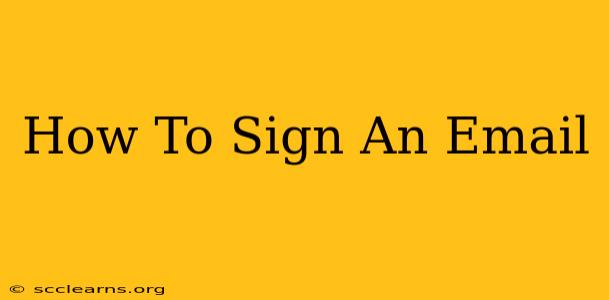Choosing the right email sign-off is surprisingly important. It can impact how your recipient perceives you, from professional to casual, friendly to distant. This guide will help you select the perfect email signature for every situation, ensuring your emails make the right impression.
Understanding the Importance of Email Signatures
Your email signature is more than just your name and contact information; it's the final flourish of your communication. A well-crafted signature leaves a lasting impression, reinforcing your brand (personal or professional) and providing easy ways for recipients to connect with you. A poorly chosen or unprofessional signature, however, can detract from your message and even damage your credibility.
Key Considerations When Choosing Your Email Sign-off:
- Your audience: Are you emailing a potential client, a colleague, a friend, or a professor? The appropriate sign-off will vary greatly depending on your relationship with the recipient.
- The context of the email: A formal email requesting a raise will need a vastly different closing than a casual email to a friend.
- Your personal brand: Do you want to project an image of professionalism, approachability, or creativity? Your signature should reflect this.
Examples of Effective Email Signatures
Here are some examples of email sign-offs categorized by formality and context:
Formal Email Sign-offs:
- Sincerely, - Classic, professional, and appropriate for most formal situations.
- Respectfully, - Shows deference and is suitable for emails to superiors or clients.
- Regards, - A slightly less formal but still professional option.
- Cordially, - Expresses warmth and politeness while maintaining professionalism.
Semi-Formal Email Sign-offs:
- Best regards, - A versatile option suitable for both professional and slightly less formal settings.
- Kind regards, - Expresses warmth and friendliness without being overly casual.
Informal Email Sign-offs:
- Best, - Suitable for colleagues, friends, and acquaintances you're familiar with.
- Cheers, - A more casual and friendly option.
- Thanks, - Appropriate if the email involved assistance or a favor.
- Talk soon, - Use only when appropriate for your relationship with the recipient.
What to Include in Your Email Signature (Beyond the Sign-off)
While the sign-off is crucial, your complete email signature should also include:
- Your full name: Clearly and legibly displayed.
- Your job title: Helpful for context and clarity.
- Your company name: If applicable.
- Your contact information: Phone number, email address, website, and social media links (where appropriate). Avoid including overly personal information.
Pro-Tip: Keep your email signature concise and visually appealing. Avoid using excessive graphics or fonts that are difficult to read.
Avoiding Email Signature Mistakes
- Overly casual sign-offs in formal emails: Avoid using informal closings like "TTYL" or "Later" in professional correspondence.
- Inconsistent signatures: Use a consistent signature across all your emails to maintain professionalism.
- Too much information: Keep your signature brief and to the point; avoid overwhelming recipients with unnecessary details.
- Ignoring your audience: Consider your audience and choose a sign-off that reflects your relationship with them.
By following these guidelines, you can craft professional and effective email signatures that enhance your communication and leave a positive lasting impression. Remember, the perfect email sign-off is context-dependent and reflects your personal brand and professionalism. Choose wisely!

